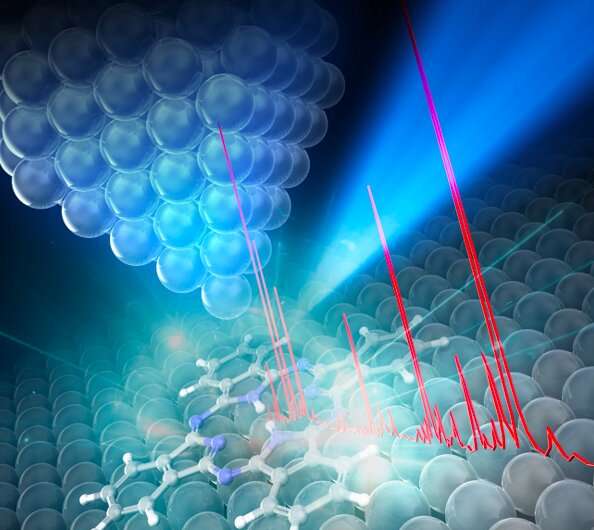July 28, 2021 feature
A single-molecule laser nanospectroscopy technique with micro-electron volt energy resolution

When molecules are excited, they can give rise to a variety of energy conversion phenomena, such as light emission and photoelectric or photochemical conversion. To unlock new energy conversion functions in organic materials, researchers should be able to understand the nature of a material's excited state and control it.
So far, many scientists have used spectroscopy techniques based on laser light in research focusing on excited states. Nonetheless, they were unable to use laser light to examine nanoscale materials, due to its limitations in so-called diffraction. The spectroscopic measurement methods applied to electron and scanning probe microscopes that can observe substances with atomic resolutions, on the other hand, are still underdeveloped.
Researchers at RIKEN, the Japan Science and Technology Agency (JST), University of Tokyo and other Institutes in Japan have recently developed a laser nanospectroscopy technique that could be used to examine individual molecules. This technique, presented in a paper published in Science, could open up new possibilities for the development of various new technologies, including light-emitting diodes (LEDs), photovoltaics and photosynthetic cells.
"It is very difficult to observe substances at the atomic levels and directly investigate the properties of the excited state of the substances, which has been one of the obstacles in energy conversion research," Hiroshi Imada, one of the researchers who carried out the study, told Phys.org. "In this research, we combine scanning tunneling microscopy (STM) with a laser spectroscopy to achieve high spatial- and energy-resolution at the same time, and with that we could unveil the nature of molecules with unprecedented precision."
The technique developed by Imada and his colleagues utilizes laser light to drive the electromagnetic field of a localized plasmon formed in the nanoscale gap between the STM tip and the metal substrate at a well-defined frequency determined by the laser energy. The lateral dimension of the plasmon field is approximately 2nm in diameter and smaller than the minimum light spot in conventional optics by two orders of magnitude. This field serves as a nanoscale monochromatic, tunable and mobile excitation source.
"The key point in our research is that the frequency of the driven plasmon is tunable by tuning the externally irradiating laser light," Imada said. "The plasmonic field precisely tuned to the molecular resonance turned out to be very effective to excite the single molecule under the STM observation, that allowed us to perform nanospectroscopy with micro-electron volt energy resolution."
While the technique developed by Imada and his colleagues is based on fundamental spectroscopy methods, it could potentially open up new research opportunities in the field of nanoscience. In fact, in contrast with conventional STM spectroscopy techniques, their method does not utilize tunneling electrons and is more similar to conventional laser spectroscopy.
"We have proven that the plasmonic field can be a nanoscale laser spot with 1/100 spot size," Imada said. "We anticipate that many kinds of laser spectroscopy can be realized with the extreme spatial resolution based on our experimental setup, just by introducing new light sources like short-pulse laser, frequency comb, synchronized two-pulses, and so on.
In the future, the technique introduced by this team of researchers could help to unlock specifically designed energy-converting functions in organic materials, by allowing scientist to tune the energy levels of molecular systems. Meanwhile, the researchers are planning to work on a time-resolved version of their technique.
"It is known that there is a trade-off between time-resolution and energy-resolution, but information about time-scale and energy-levels are both very important to correctly understand the dynamic process taking place in the excited state," Imada said. "We plan to develop ultra-fast nanospectroscopy that is compatible with the precise nanospectroscopy developed here to revolutionize the understanding of energy conversion in molecular systems."
More information: Single-molecule laser nanospectroscopy with micro-electron volt energy resolution. Science (2021). DOI: 10.1126/science.abg8790
Journal information: Science
© 2021 Science X Network





















